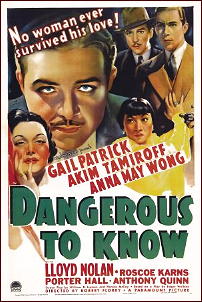November 2017
Monthly Archive
Mon 20 Nov 2017

THE UNDERWORLD STORY. United Artists, 1950. Dan Duryea, Herbert Marshall, Gale Storm, Howard Da Silva, Michael O’Shea, Mary Anderson, Harry Shannon, Roland Winters. Based on a story by Craig Rice. Director: Cy Endfield.
There are two good reasons to watch this not-quite-noir crime film, and one of the them is Dan Duryea. As reporter Mike Reese, as brash as they come, he is bounced and then blacklisted from all of the big city newspapers. Taking a loan from mobster Howard Da Silva, the second reason to see this movie, he fast-talks his way into being a partner in a small weekly paper out in the suburbs, one owned by Gale Storm’s character.

She hesitates, but you know Dan Duryea, or you probably do. She’s o match for his affable gift of gab, while all he while you can tell what he’s thinking: what it is that’s in it for him? When a black maid is accused of killing her employer, the wife of the son of one of the owners of one of the big city newspapers, he sees his chance to make a name for himself, and grabs it. No moss under this guy’s feet.

Duryea’s character will keep you off balance all of the way through the movie, Just when, you wonder, will he cross all the way over and be “good”? In spite of the title, this is more of a murder mystery than it is a gangster film — but not a detective story, not at least as far as the viewer is concerned, since we know whodunit almost as son as he’s done it. It takes a while for Duryea and Storm to figure it out, though.
And in case you’re wondering, there is a trace of romance in the air, but not much more than a trace. Every time you think the story’s going there, Duryea does something that simply snaps Gale Storm’s head back. Literally.
Sun 19 Nov 2017
REVIEWED BY DAN STUMPF:

JULES AND JIM. Cinédis, France, 1962; originally released as Jules et Jim. Janus Films, US, 1962; subtitled. Jeanne Moreau, Oscar Werner (Jules), Henri Serre (Jim), Vanna Urbino, Serge Rezvani, Anny Nelsen. Screenplay: François Truffaut, based on the novel by Henri-Pierre Roché. Director: François Truffaut.
A film seen recently for the first time in many Years: Jules and Jim, Francois Truffaut’s achingly elegiac look at Love and Friendship, and a film which vividly recalls for me some very dear and painful memories, which explains why a jaded, alopecic, former Cop should find himself blinking back tears once again to watch an old movie.

Looking at the film objectively, I could note that some of the stylings that were daring and innovative when Truffaut did them in ’61 have become standard and even cliché by now, but I’d have to say they’ve never been better or more appropriately used since he first strutted them out. In particular, his monotone narrator is positively heart-rending at times. Of course the casting is a once-in-a-lifetime ensemble (whatever happened to Henri Serre?) and every bit player and future star gets shown off to marvelous advantage.
Yet even I must admit there are one or two moments that don’t really work and –alas! — they are crucial moments indeed. They come, fortunately, too late to actually ruin the movie, but they vitiate its effectiveness more than a bit. So I’d have to put this one in a class with fine films like The Tall T or Johnny Guitar, a film of truly remarkable depth and feeling, if not of unalloyed brilliance.
Sat 18 Nov 2017
A 1001 MIDNIGHTS Review
by Robert E. Briney

JOHN DICKSON CARR – Castle Skull. Henri Bencolin #2. Harper & Brothers, hardcover, 1931. Reprint editions include: Pocket #448, paperback, 1947. Berkley G-412, paperback, 1959; F960, paperback, 1964. Zebra, paperback, 1987.
Carr’s writing career began with a sports column in a local newspaper at the age of fourteen. During his prep-school years at the Hill School, he was already writing locked-room stories and an Oppenheim-style serial. At Haverford College he worked on the college’s literary magazine, The Havelfordian, and it was here that the first stories about his Parisian magistrate-detective, Henri Bencolin, appeared.
When he wrote his first full-fledged mystery novel, it was only natural that he should use Bencolin as his detective. Bencolin’s debut in book form was in It Walks by Night (1930), and three other books in the series followed within the next two years.

Castle Skull is the second of Bencolin’s recorded exploits. The setting is Schloss Schadel, a castle on the Rhine River near the city of Coblenz. The castle had been the home of the world-famous magician Maleger. Some time before the start of the story, Maleger had disappeared from a railway carriage that was under constant observation; his drowned body later turned up in the Rhine.
In his will he left Castle Skull jointly to his two friends, the actor Myron Alison and the financier Jerome D’Aunay. Now Alison has been murdered in spectacular fashion: “The man’s vitality was apparently enormous. He had been shot three times in the breast, but he was alive when the murderer poured kerosene on him and ignited it. He actually got to his feet and staggered out in flames across the battlements before he fell.”

Bencolin, on vacation from his official duties, is persuaded by D’Aunay to investigate Alison’s death. He is accompanied on the case by his “Watson,” an American writer named Jeff Marle, who narrates the story.
This is the young Carr in full flight: a meticulously constructed formal detective story cloaked in extravagant melodrama and exuberantly macabre trappings, peopled by doom-laden characters. The relative smoothness and restraint of Carr’s later work is little in evidence, but there is no denying the power and fascination of the story.
———
Reprinted with permission from 1001 Midnights, edited by Bill Pronzini & Marcia Muller and published by The Battered Silicon Dispatch Box, 2007. Copyright © 1986, 2007 by the Pronzini-Muller Family Trust.
Sat 18 Nov 2017
REVIEWED BY JONATHAN LEWIS:

HOT ROD RUMBLE. Allied Artists, 1957. Leigh Snowden, Richard Hartunian, Wright King, Joey Forman, Brett Halsey. Director: Leslie H. Martinson.
This one’s a surprisingly entertaining oddity, a juvenile delinquent exploitation film featuring a lead actor who never made another film before or since: Richard Hartunian, an effective method actor with more than a passing similarity to Marlon Brando. He portrays Big Artie, a hot-tempered mechanic affiliated with the Road Devils, a local racing outfit. He’s got his mind dead set on local beauty Terri (Leigh Snowden, who portrayed a character named Cheesecake in Robert Aldrich’s Kiss Me Deadly) and is more than willing to throw a punch or two to get his girl back after she tells him it’s over.

So it’s no surprise that when Terri and another guy get run off the road, all the attention turns to Arnie. Even his parents seem to think he’s capable of such reckless and deadly behavior. With nowhere to turn, Arnie seeks the assistance of fellow Road Devil, Ray Johnson (Wright King). Arnie does not realize that it was Ray who was responsible for running Terri and her friend Hank off the road. Terri survives the incident, but Hank does not. This makes Arnie the primary target of his fellow Road Devils. They are ready to get their revenge.

At times the film feels more like a teenage melodrama than a crime film. But there’s enough grittiness and small town teenage angst as well as the obligatory final car race to make Hot Rod Rumble a worthwhile movie to seek out. Add to that the exceptional jazz score by Alexander “Sandy†Courage (you can listen to the main theme here), and you’ve got yourself a movie that is as much a time capsule as a work of commercial popular entertainment. Not great by any stretch of the imagination, but better than you might expect, and a movie that deserves a proper commercial DVD release.
Fri 17 Nov 2017
Posted by Steve under
Reviews1 Comment
IT IS PURELY MY OPINION
Reviews by L. J. Roberts
CHARLES TODD – A Casualty of War. Bess Crawford #9. Setting: France/England, World War I. William Morrow, hardcover, September 2017.

First Sentence: Lieutenant Morrison died as dawn broke on the Friday morning, a casualty of war.
Field nurse Bess Crawford treats a patient, Captain Travis, disoriented from a head wound who believes Lt. James Travis, a distant cousin and Englishman, deliberately shot him. Although released, he is brought back still insisting on the same story. Upon Bess’s return to England, she finds the captain strapped to a hospital bed and being treated for a brain injury. Bess enlists the help of Sgt. Major Simon Brandon to unravel Travis’ story and find the truth.
From the very start, Todd touches one’s emotions. Although it’s coming to the end of the war, it is still very active and provides an interesting perspective on events and even the attitudes by some regarding providing medical treatment to captured German soldiers.
At first, one may believe one knows where the story is going. As it progresses, things do change and a twist makes things more interesting. And, as they say, the plot thickens even more.
Bess is such a strong character. Her nature is well-explained, as is her dedication.
The story does read a bit like a melodrama at times. However, it turns out there is a very clever, and well-hidden, motive.
A Casualty of War takes one from the battles of France, to London, to a small English town, all in search for truth. With the war coming to an end, it is going to be interesting to see where the series will go from here.
Fri 17 Nov 2017
Posted by Steve under
Reviews[2] Comments
EDWARD S. AARONS – Assignment Mara Tirana. Sam Durell #12. Gold Medal s1036, paperback original; 1st printing, September 1960.
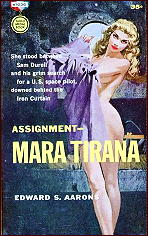
CIA agent Sam Durell has a twofold problem in this adventure: first, the USA’s first man into space has come down somewhere in the Balkans, far behind the Iron Curtain, and second, his lady friend Dierdre, who has lately become slightly involved with the previously mentioned astronaut, has also gotten herself captured, in her case by the Soviet agent anxious to keep Durell off the trail.
There is one other complication, and that is Mara Tirana, a Soviet agent who wants to defect, but whose brother most emphatically does not. As is always the case in these adventures of San Durell, the scenery and other background is vividly etched in picturesque dtail, but as you can tell, there’s also a little too much plot here to be held in at only 175 pages. It’s bulging at the seams, and something has to give — which is a heck of a complaint to make about a book: it’s just not long enough!
PostScript: If you’ve never read one of the Sam Durell novels, I thought I’d give you a brief taste of them. The excerpts below should give you an idea of the details that Aarons provided his readers abut locales of the world that back when these books were written were far off the beaten track for all but the most seasoned travelers. In fact, most of them still are today.
From pages 64 and 65:
“They were on the main highway out of Vienna, speeding northeast into the Marchfield District, where the Danube was over three hundred yards wide and its channel was divided by numerous small islands. The frontier, where the river passed through a narrow gap between the lower spurs of the Carpathians, was thirty miles away. Here, in the night and rain, the countryside of church spires and fertile fields was dark and peaceful.”
“…They crawled ahead,easing their way through the gloom. Durell could see the Danube now, a broad reach of rain-dimpled water, with the opposite bank beyond several small islands, probably in Czech territory at this point. To the east was the loom of hills that narrowed the gap for the river to pass through the spurs of the Carpathians. Lights twinkled o the river, and there were moving objects, barges and small steamers chuffing, with diesel engines muttering in the mist, and an occasional glimmer of red or green running from the international river traffic.”
— Reprinted from Mystery*File #23,, July 1990 (slightly revised).
Thu 16 Nov 2017
REVIEWED BY DAN STUMPF:
SECRETS OF THE FRENCH POLICE. RKO, 1932. Gwili Andre, Gregory Ratoff, Frank Morgan and John Warburton. Written by Samuel Ornitz and Robert Tasker from magazine stories by Ashton Wolfe. Director: A. Edward Sutherland
SECRETS OF SCOTLAND YARD. Republic, 1944. Edgar Barrier, Stephanie Bachelor, C. Aubrey Smith, Lionel Atwill, Martin Kosleck, John Abbott and Mary Gordon. Written by Denison Clift. Directed by George Blair.

Two very different films, each lots of fun in its own way.
French Police is a lavish Selznick production, with splendid sets, moody photography and lots of lurid pre-Code mischief as it weaves the tale of General Moloff (Gregory Ratoff) a Russo-Chinese criminal mastermind (you know the type) who schemes to abduct an innocent young flower girl (the lovely Gwili Andre) and pass her off as Princess Anastasia, using hypnosis and drugs.
That would be plenty for any self-respecting super-villain, but Moloff goes the extra mile, murdering inconvenient witnesses and leaving notes written in the victim’s blood incriminating other inconvenient witnesses — and that’s just when he’s in a hurry; given time and leisure, he drains his victims’ blood, covers them with plaster, and displays them as statues in his sinister palace, guarded by malevolent Orientals and surrounded with death traps.

In short, a villain who takes his arch-fiendishness seriously, with the sort of old world polish one just doesn’t find in scoundrels these days.
All of this is off-set knowingly by Frank Morgan as a sharp police inspector who recruits the flower girl’s burglar-boyfriend (John Warburton) to penetrate Moloff’s fiendish lair and unhatch his diabolical plots. And though I’m not sure “unhatch†is actually a word, Morgan and Warburton underplay their parts beautifully (I particularly enjoyed the scene where Warburton explains to Morgan why he thinks the World owes him a living), adding a touch of cynicism to the theatrical goings-on that keeps it slightly — very slightly—grounded in reality amid the cliffhangers and killings.
The result is a film that seems part pulp-magazine and part send-up of pulp magazines, and an immensely satisfying blend of both.
Scotland Yard, on the other hand, is a cheap little thing from Republic, a studio that knew how to do cheap movies just right, with a better than usual cast for them.

We start with the defeat of Germany in World War I, with the German High Command already plotting their next strike by planning to get a mole into the decoding unit of the British War Department. Fast-forward to 1939, and the decoding unit run by C. Aubrey Smith (he of the lantern jaw and eyebrows like blunt instruments) and staffed with familiar character actors. Edgar Barrier plays the star decoder, but they no sooner break the code than he’s found dead on the floor, with his work erased.
So it seems that the Germans got their mole in place, and the question is, which one is it? And how to find out? Fortunately for the allied cause and the film’s title, Barrier has a twin brother who works for Scotland Yard, and he steps into the dead man’s shoes to find out.

What follows is fifty agreeable minutes of cat-and-mouse, helped along considerably by a cast of suspects that includes Lionel Atwill, John Abbott and Martin Kosleck at his sinister best, the whole thing — punctuated by vigorous fist-fights in the Republic manner.
But there are also some telling bits of atmosphere rare for Republic: fog-shrouded streets, country cottages, and even Mary Gordon on leave from Universal’s Sherlock Holmes series as a cheerful housekeeper. And perhaps best of all, a quiet moment in the decoding office as the staff solemnly listens to King George VI’s halting radio speech declaring war, and everyone stands at attention when the radio plays “God Save the King.â€
It’s one of those little touches that lifts Secrets of Scotland Yard out of the B-Movie rut, and, together with that quintessential movie cast, help to make it memorable.
Wed 15 Nov 2017
REVIEWED BY WALTER ALBERT:
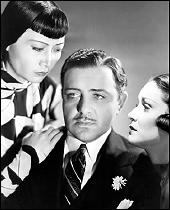
DANGEROUS TO KNOW. Paramount, 1938. Shown at Cinevent. May 1994. Anna May Wong, Akim Tamiroff, Gail Patrick, Lloyd Nolan, Harvey Stephens, Anthony Quinn, Roscoe Karns, Porter Hall. Based on the novel On the Spot (1931) by Edgar Wallace. Director: Robert Florey.
A film that many viewers liked a lot was Dangerous to Know with the unlikely, but dynamite team of Anna May Wong and Akim Tamiroff. Even dependably good Lloyd Nolan took a back seat to the potent emoting, all the more effective because they both gave restrained performances in roles that could have been served as grade-A ham.
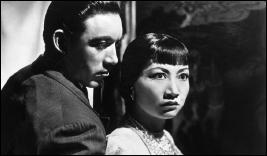
The film is based on an Edgar Wallace novel and play that starred Charles Laughton in the London production, and Wong played her role on Broadway and on the road in 1930-31. Tamiroff is Stephen Recka, a crime lord whose house is impeccably run by is mistress, Madame Lan Ying (Wong). (Hedda Hopper has a small role of a society matron who characterizes Wong as Recka’s “hostess,” with an inflection in her voice that leaves no douby about her opinion of Ying’s relationship to Recka.)
The high point of the film (and its climax) occurs as Recka plays the organ and Lan Ying hovers, apparently waiting for the opportunity to kill traitorous Recka. (Tamiroff plays the crime lord with just the right blend of cultivation and ruthless cruelty to give the character charm and draw some audience sympathy.)
Tue 14 Nov 2017
REVIEWED BY BARRY GARDNER:
CAROL O’CONNELL – Mallory’s Oracle. Kathleen Mallory #1. G. P. Putnam’s Sons, hardcover, 1994. Jove, paperback, 1995.
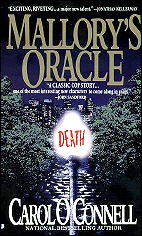
O’Connell is a painter turned novelist, and this is her first. Putnam thinks it’s going to be a good one. They paid a lot of money for it, and it’s already been published in England and sold to several other countries.
Kathleen Mallory was a street kid and she was taken in at the age of 12 by a NYPD cop and his wife. Now she’s a Sergeant in the same department, and her father in all the real sense of the word has been murdered at the same time as the latest victim is killed by a serial killer who preys on old women.
The Department places her on compassionate leave, but compassion is not a word she understands very well. She’s beautiful, a crack shot and a computer whiz, and underneath a thin veneer is a tough and nearly as amoral as the child she used to be. Mercy is another word that has little relevance to her as she begins tracking her prey.
O’Connell may be this year’s Minette Walters, and this could easily be an Edgar winner for either First or Best Novel. Yes, I thought it was that good. It’s a powerfully written book, and often beautifully so. An Example: “She lay still in the body and quiet.”
And watch for the passage about the insane pigeon — surely none of the more unlikely subjects upon which to base a memorable paragraph, but there it was. The third person narrative is mostly from Mallory’s viewpoint, though there are several illuminating shifts.
The plot is convoluted, with maybe one or two too many threads to the skein, but the book’s strengths lie in O’Connell’s prose and the vivid characterizations of Mallory and a number of others. It isn’t a perfect book, but it’s a very, very strong one, and I think the field has another star here, folks.
— Reprinted from Ah Sweet Mysteries #14, August 1994.
The Kathleen Mallory series —
1. Mallory’s Oracle (1994)
— 1995 Anthony Award — First Novel (Nominee)
— 1995 Dilys Award — Mystery Novel (Nominee)
— 1995 Edgar Allan Poe Award — First Novel (Nominee)
2. The Man Who Lied to Women (1995) aka The Man Who Cast Two Shadows
3. Killing Critics (1995)
4. Flight of the Stone Angel (1997) aka Stone Angel
5. Shell Game (1999)
6. Crime School (2002)
7. The Jury Must Die (2003) aka Dead Famous
8. Winter House (2004)
9. Find Me (2006) aka Shark Music
10. The Chalk Girl (2012)
11. It Happens in the Dark (2012)
12. Blind Sight (2016)
Mon 13 Nov 2017
REVIEWED BY DAVID VINEYARD:
THE GUILT OF JANET AMES. Columbia Pictures, 1947. Rosalind Russell, Melvyn Douglas, Sid Caesar, Betsy Blair, Nina Foch, Hugh Beaumont, Denver Pyle (debut uncredited). Screenplay by Louella MacFarlane, Allen Rivkin & Devery Freeman, based on the novel by Lenore Coffee. Directed by Henry Levin.

The Guilt of Janet Ames is an uneven film. An oddity in its time of films about the trauma of returning soldiers, it is about the trauma of a war widow (Rosalind Russell in the title role) instead, and more about self-inflicted wounds than grief.
In an era when the psychological film came into its own, it both embraces and dares to poke subtle fun at the genre (a monologue by Sid Caesar that is both very funny and a self-critique appears in the middle of the film), a woman’s picture with a noirish edge, a sometimes too heavy-handed psychological melodrama, a handsomely designed and experimental attempt to show the mental state of its heroine on screen (with Frank Tuttle listed among the design credits), and for a brief section a rather bright romantic comedy of the type its stars were best known for. Einstein and the theory of Relativity even play a role.

It is also schmaltzy, powerful, borderline sadistic, and a fine showcase for Russell and Douglas.
On her way to meet a man, Janet Ames is hit by a car and taken to a local Los Angeles hospital. In her pocket is a Congressional Medal of Honor and a list of five men’s names.
One of those names is Smithfield Cobb (Melvyn Douglas), a once famous reporter who has poured himself into a bottle and has just about hit bottom. He has a last chance if he takes a plane to Seattle at midnight (or does he?), assuming he can get past Danny’s, the dive he hangs out in.
An important metaphor is introduced here, Smitty’s penchant for discussing the George DuMaurier play and novel Peter Ibbetson with the bartender, a story about a man who escapes his prison cell by flights of fancy. It’s never clearly established if that plane ticket is a real chance, or just another escape mechanism.

Smitty used to work the hospital desk before he lost that job too, and the police recognize his name on the list and summon him to identify the woman, and he recognizes her all too well. He carries her picture in his wallet though he never met her.
Janet Ames is only shaken by her accident but is hysterically paralyzed, refusing to leave the hospital or her wheelchair. She turns out to be bitter and angry because her husband David threw himself on a grenade during the war to save five other men. Why did he have to die, and what value did they have in return?
This could easily have played out as a heartwarming story about sacrifice, but to its credit, even when it seems to be going there, something more is at play, because The Guilt of Janet Ames is a mystery, with Douglas cast as detective, defense attorney, and prosecutor, and Russell, as the embittered and unreasonable title character victim, defendant, and plaintiff.

And note the title, it isn’t called The Innocence of Janet Ames.
I won’t give them away, but there are as many twists to this plot as any Agatha Christie novel, and at any given moment, you don’t quite know what you think you do. Ultimately it is about forgiveness, mostly of ourselves, and about the kind of hidden trauma left by the war, any war, among those who fought and who waited.
It worked for me. If the romance is a bit contrived, if the mood is at times uneven, if fate’s Woolrichian hand seems all too obvious in places, the leads pull it off, and it is certainly an interesting film to look at. I would be surprised if any two viewers see this film the same way.
Like the truth in this film, your experience will almost certainly vary.
« Previous Page — Next Page »



